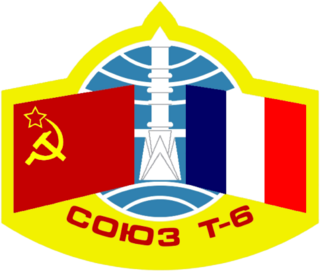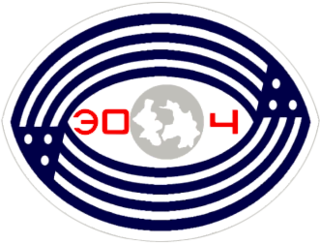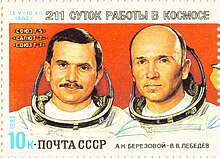
The Salyut programme was the first space station programme, undertaken by the Soviet Union. It involved a series of four crewed scientific research space stations and two crewed military reconnaissance space stations over a period of 15 years, from 1971 to 1986. Two other Salyut launches failed. In one respect, Salyut had the task of carrying out long-term research into the problems of living in space and a variety of astronomical, biological and Earth-resources experiments, and on the other hand the USSR used this civilian programme as a cover for the highly secretive military Almaz stations, which flew under the Salyut designation. Salyut 1, the first station in the programme, became the world's first crewed space station.

The Progress is a Russian expendable cargo spacecraft. Its purpose is to deliver the supplies needed to sustain a human presence in orbit. While it does not carry a crew, it can be boarded by astronauts when docked to a space station, hence it is classified as crewed by its manufacturer. Progress is derived from the crewed Soyuz spacecraft and launches on the same launch vehicle, a Soyuz rocket.

Salyut 1 (DOS-1) was the world's first space station launched into low Earth orbit by the Soviet Union on April 19, 1971. The Salyut program followed this with five more successful launches of seven more stations. The final module of the program, Zvezda (DOS-8), became the core of the Russian segment of the International Space Station and remains in orbit.

Salyut 6, DOS-5, was a Soviet orbital space station, the eighth station of the Salyut programme. It was launched on 29 September 1977 by a Proton rocket. Salyut 6 was the first space station to receive large numbers of crewed and uncrewed spacecraft for human habitation, crew transfer, international participation and resupply, establishing precedents for station life and operations which were enhanced on Mir and the International Space Station.

Salyut 7 was a space station in low Earth orbit from April 1982 to February 1991. It was first crewed in May 1982 with two crew via Soyuz T-5, and last visited in June 1986, by Soyuz T-15. Various crew and modules were used over its lifetime, including 12 crewed and 15 uncrewed launches in total. Supporting spacecraft included the Soyuz T, Progress, and TKS spacecraft.
Soyuz 35 was a 1980 Soviet crewed space flight to the Salyut 6 space station. It was the 10th mission to and eighth successful docking at the orbiting facility. The Soyuz 35 crew were the fourth long-duration crew to man the space station.
Soyuz T-4 was a Soviet space mission which launched the crew of Salyut 6 EO-6, the sixth and final long-duration crew of the Salyut 6 space station. It was launched on 12 March 1981 and docked with the station the next day. During their stay, the EO-6 crew was visited by Soyuz 39 and Soyuz 40. Soyuz T-4 returned to Earth on 26 May 1981; its crew were the last to have inhabited Salyut 6.

Soyuz T-6 was a human spaceflight to Earth orbit to the Salyut 7 space station in 1982. Along with two Soviet cosmonauts, the crew included a Frenchman, Jean-Loup Chrétien.
Soyuz T-7 was the third Soviet space mission to the Salyut 7 space station. Crew member Svetlana Savitskaya was the first woman in space in almost twenty years, since Valentina Tereshkova who flew in 1963 on Vostok 6.
Soyuz T-13 was a Soyuz mission, transporting personnel to the Soviet space station Salyut 7. The eighth expedition to the orbital station, the mission launched from Baikonur Cosmodrome, atop a Soyuz-U2 carrier rocket, at 06:39:52 UTC on June 6, 1985. It is of note because it marked the first time a spacecraft had docked with a 'dead' space station, and the first time such a station had been returned to operational status following repairs.

Soyuz TM-30, also known as Mir EO-28, was a Soyuz mission, the 39th and final human spaceflight to the Mir space station. The crew of the mission was sent by MirCorp, a privately funded company, to reactivate and repair the station. The crew also resupplied the station and boosted the station to an orbit with a low point (perigee) of 360 and a high point (apogee) of 378 kilometers ; the boost in the station's orbit was done by utilizing the engines of the Progress M1-1 and M1-2 spacecraft. At that time a transit between Mir and the International Space Station was already impossible - such a transfer was deemed undesired by NASA - and the orbital plane of ISS had been chosen some time before to be around 120 degrees away from that of Mir. The mission was the first privately funded mission to a space station.

Progress 1, was a Soviet unmanned Progress cargo spacecraft which was launched in 1978 to resupply the Salyut 6 space station. It was the maiden flight of the Progress spacecraft, and used the Progress 7K-TG configuration. It carried supplies for the EO-1 crew aboard Salyut 6, which consisted of Soviet cosmonauts Yuri Romanenko and Georgy Grechko. The cargo carried by Progress 1 also included equipment for conducting scientific research, and fuel for adjusting the station's orbit and performing manoeuvres.

Progress 7K-TG, was a Soviet uncrewed spacecraft used to resupply space stations in low Earth orbit. Forty three flew, delivering cargo to Salyut 6, Salyut 7, and Mir. It was the first version of the Progress spacecraft to fly, and spawned later derivatives including the Progress-M which replaced it, and the later Progress-M1.

Mir EO-4 was the fourth long-duration expedition to the Soviet space station Mir. The expedition began in November 1988, when crew members Commander Aleksandr Volkov and Flight Engineer Sergei Krikalev arrived at the station via the spacecraft Soyuz TM-7. The third crew member of EO-4, Valeri Polyakov, was already aboard Mir, having arrived in August 1988 part way through the previous expedition, Mir EO-3.

Progress 2 was an unmanned Progress cargo spacecraft launched by the Soviet Union in 1978 to resupply the Salyut 6 space station. It used the Progress 7K-TG configuration, and was the second Progress mission to Salyut 6. It carried supplies for the EO-2 crew aboard Salyut 6, as well as equipment for conducting scientific research, and fuel for adjusting the station's orbit and performing manoeuvres.

Progress 3 was an unmanned Progress cargo spacecraft launched by the Soviet Union in 1978 to resupply the Salyut 6 space station. It used the Progress 7K-TG configuration, and was the third Progress mission to Salyut 6. It carried supplies for the EO-2 crew aboard Salyut 6, as well as equipment for conducting scientific research, and fuel for adjusting the station's orbit and performing manoeuvres.

Progress MS-01, identified by NASA as Progress 62P was a Progress spaceflight operated by Roscosmos to resupply the International Space Station (ISS) in 2015. It was launched on 21 December 2015, to deliver cargo to the ISS. Progress MS-01 is the first vehicle in the Progress-MS series.

Progress MS-03, identified by NASA as Progress 64P, was a Progress spaceflight operated by Roscosmos to resupply the International Space Station (ISS). It was the first Progress MS to have an external compartment for releasing satellites.

Progress 16 was a Soviet uncrewed Progress cargo spacecraft, which was launched in October 1982 to resupply the Salyut 7 space station.













